The critically acclaimed Uncharted video game series follows the exploits of adventurer Nathan Drake in his search for various archaeological treasures around the world. The games combine a cinematic narrative style with ample doses of character development and high-octane action sequences, in what’s become a widely copied formula for success. The reason for that is very simple: it works.
Indeed, the Uncharted games are some of the most fun I’ve ever had behind a video game controller, and the fourth and final installment in the series is easily the most ambitious episode yet.
Let’s take a look.

Previously, on Uncharted…
With three previous games spanning a decade, the Uncharted saga is one of the most fascinating and entertaining stories in video game history.
It’s worth pointing out that, while all three previous games were originally released on the PS3, they have recently been remastered in high-definition and re-released as native PS4 games in a single disc bundle. If you haven’t played them, this is an excellent chance to get acquainted with the story before playing Uncharted 4, which I strongly recommend doing.
Before we get into the specifics of Uncharted 4: A Thief’s End, let’s take a quick detour around Drake’s past.
Drake’s Fortune
It was back in 2007 when we first got to meet Nathan “Nate” Drake, a cheeky adventurer, treasure hunter — and occasionally, thief — who claims to be a direct descendant of 16th-century British explorer Sir Francis Drake.
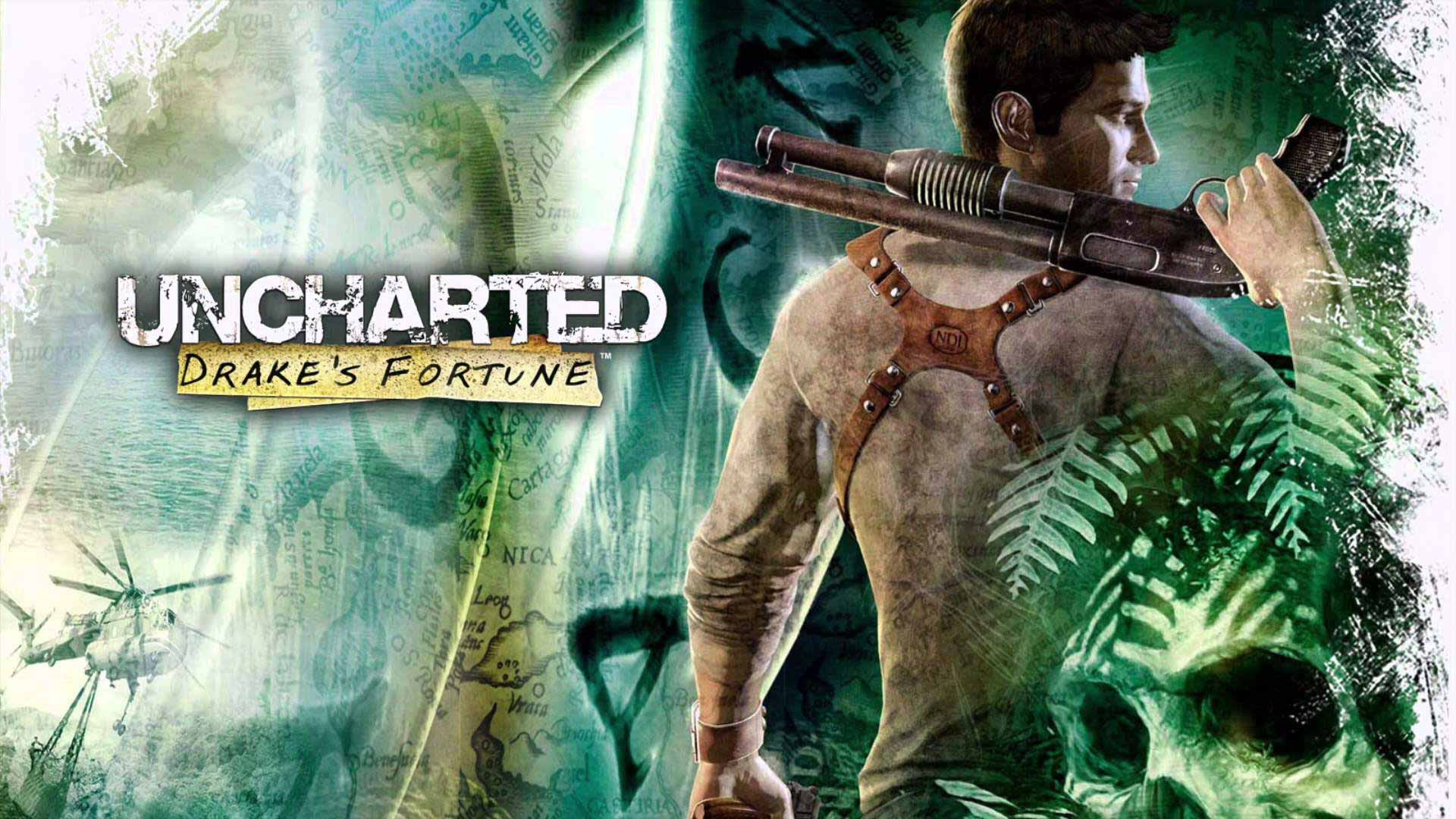
The first installment of Uncharted, known as Drake’s Fortune.
In his first big adventure, Nate teams up with journalist Elena Fisher and long-time partner and mentor Victor “Sully” Sullivan to follow a trail left by Sir Francis himself to El Dorado, a lost treasure allegedly found by the British explorer in one of his many voyages.
This first entry in the series had its fair share of flaws and rough edges, but it was remarkable for the way it managed to seamlessly blend a rich story with interesting, deep-layered characters and fun, if a bit repetitive gameplay that combined long passages traversing gorgeous exotic locations with highly dynamic, action-packed combat scenes. Think of it as Indiana Jones meets Tomb Raider, and you’re just about there.
This recipe for success became the foundation all subsequent games in the series — and more than a few others — have been built upon since then. For Naughty Dog, it was like striking gold.
Among Thieves
Released only two years after Drake’s Fortune, the second installment in the Uncharted series took a gigantic leap forward in every possible way, quickly establishing itself as one of the best video games of its generation.

The second chapter in the Uncharted series, Among Thieves.
Inspired by Marco Polo’s travels through Asia, the story of Uncharted 2: Among Thieves has Drake team up with fellow thieves Chloe Frazer and Harry Flynn in their search for the lost city of Shambhala, the last known location of the Cintamani Stone, a legendary sapphire rumored to possess magical powers capable of granting immortality. Along the way, Drake will once again cross paths with Sully and old flame Elena Fisher, while they desperately try to stay ahead of Russian warlord Zoran Lazarević, who is also determined to get the Cintamani Stone for himself.
To put it bluntly, everything about Uncharted 2 is bigger and better than what we’d previously seen in Drake’s Fortune. Everything. Right from the breathtaking opening scene, where Drake regains consciousness only to find himself hanging for dear life from a quickly collapsing train with a bullet hole in his stomach, it becomes abundantly clear that the stakes have been raised dramatically.
Next time someone tells you the old “sequels always suck” trope, just kindly point them to Uncharted 2 and drop the mic. It’s not just good, it’s adventure and storytelling at their very best, and a piece of video game history from a studio at the top of their game.
Drake’s Deception
The third chapter of the Uncharted saga was released in 2011, a further two years after the massive hit that was Among Thieves. By then, with Naughty Dog consolidated as one of the best and most talented video game studios ever and the PS3 platform reaching maturity, expectations were naturally sky-high.

Drake’s Deception was the third instalment in the Uncharted series.
For the most part, Uncharted 3: Drake’s Deception didn’t disappoint, and was successful enough to become the best-selling game in the series, albeit not by much. However, it arguably failed to impress on the same level its predecessor did. That’s understandable, though. After all, Among Thieves was an incredibly tough act to follow.
The game kicks off with Nate and Sully meeting an English gangster in a shady club for a trade: a briefcase full of money for Nate’s famous ring, which Nate claims used to belong to Sir Francis Drake. However, Nate soon realizes the money is fake, the deal is blown and everything kind of goes downhill from there. As we later find out, the ring is the key to unlocking a mysterious clue left behind by Sir Francis himself. This time around, we’re looking for Iram of the Pillars, a legendary lost city described in the journals of British archaeologist T.E. Lawrence.
Despite the similarities of its plot with that of Uncharted 2 — the search for yet another lost city, a double-crossing partner, the recurring will they/won’t they relationship between Nate and Elena — there was still lots to love about Uncharted 3, including some of the best graphics in the PS3 generation, and a rich story that takes us through some of the largest and most impressive set pieces to date in the series. In particular, there’s a scene where Nate tries to escape from a sinking ship that’s up there with the best the video game world has to offer in terms of tension, drama, and sheer scope.
It may not have been as revolutionary as Uncharted 2, but at the end of the day, Uncharted 3 was still a really, really good game, and a fitting conclusion to the Uncharted trilogy… that is, until November of 2013, when Naughty Dog announced they were developing the fourth — and this time, final — episode in the series.
A Thief’s End
Uncharted 4: A Thief’s End, released in May of 2016, is the conclusion to the Uncharted series, and takes place three years after the events of Uncharted 3. The game was formally announced at the E3 conference in June of 2014, and Naughty Dog shared a few small peeks at gameplay at various subsequent gaming events, raising expectations among the series’ fans to fever pitch levels for well over a year prior to its release.
The good news is, Uncharted 4 delivers big on those expectations, and then some. The bad news is, if we’re to believe Naughty Dog, the ride has finally come to an end — but what a ride it’s been.

In Medias Res
In typical Uncharted fashion, the game throws you right in the middle of the action without previous warning. Immediately after the customary introductory quote — from Henry Avery this time — we find Nate right in the middle of a boat chase, speeding through a tropical storm with a man called Sam in a make-it-or-break-it attempt to reach a shadowy island.
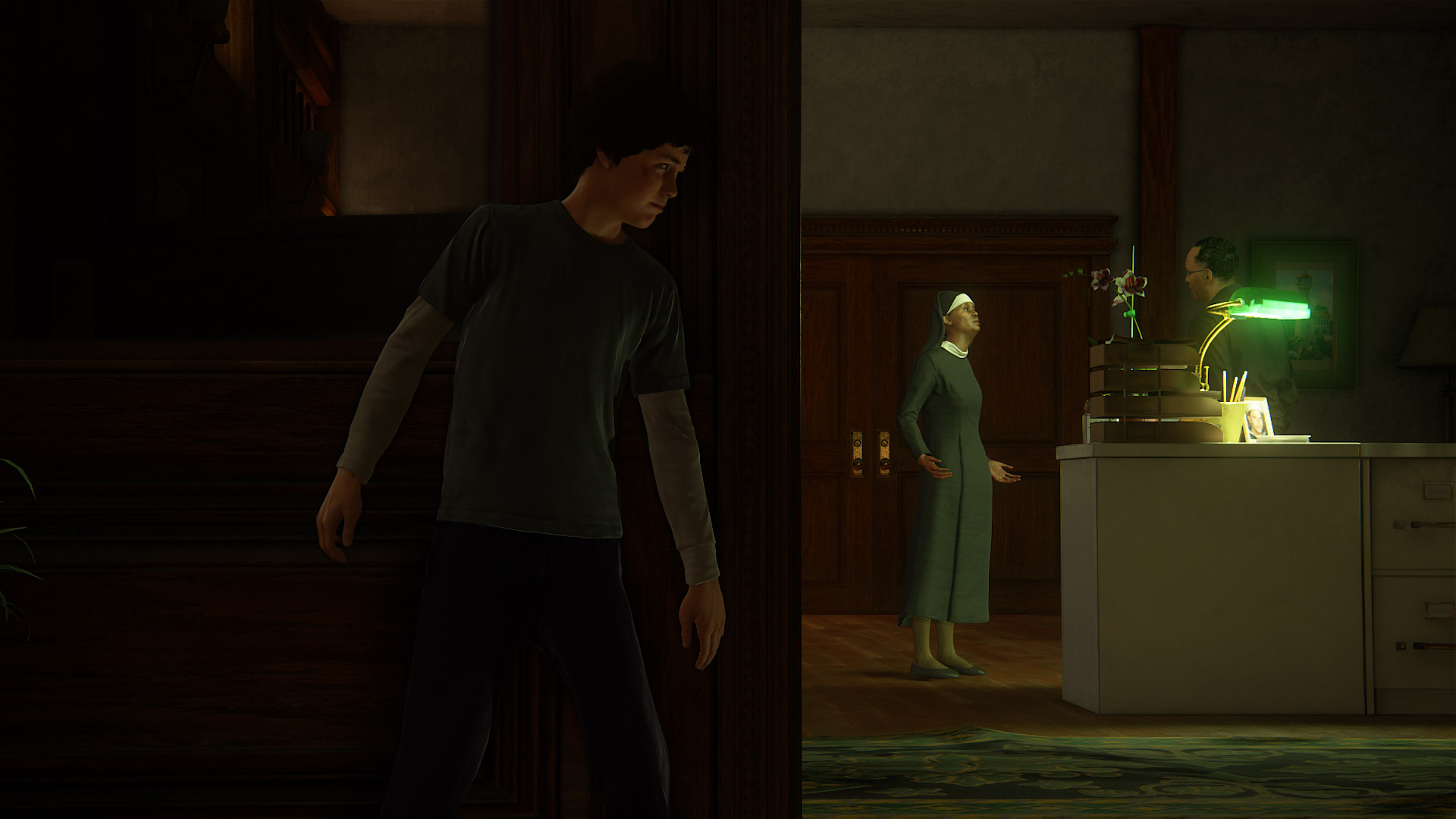
Once we play through the inaugural scene, the game gives us a chance to catch our breath with a flashback to Nate’s childhood. Nate’s living in an orphanage, and he’s apparently a conflictive kid who often gets into trouble. It is at this point that we find out Sam is actually Nate’s older brother, whose existence somehow went unmentioned in the previous games.

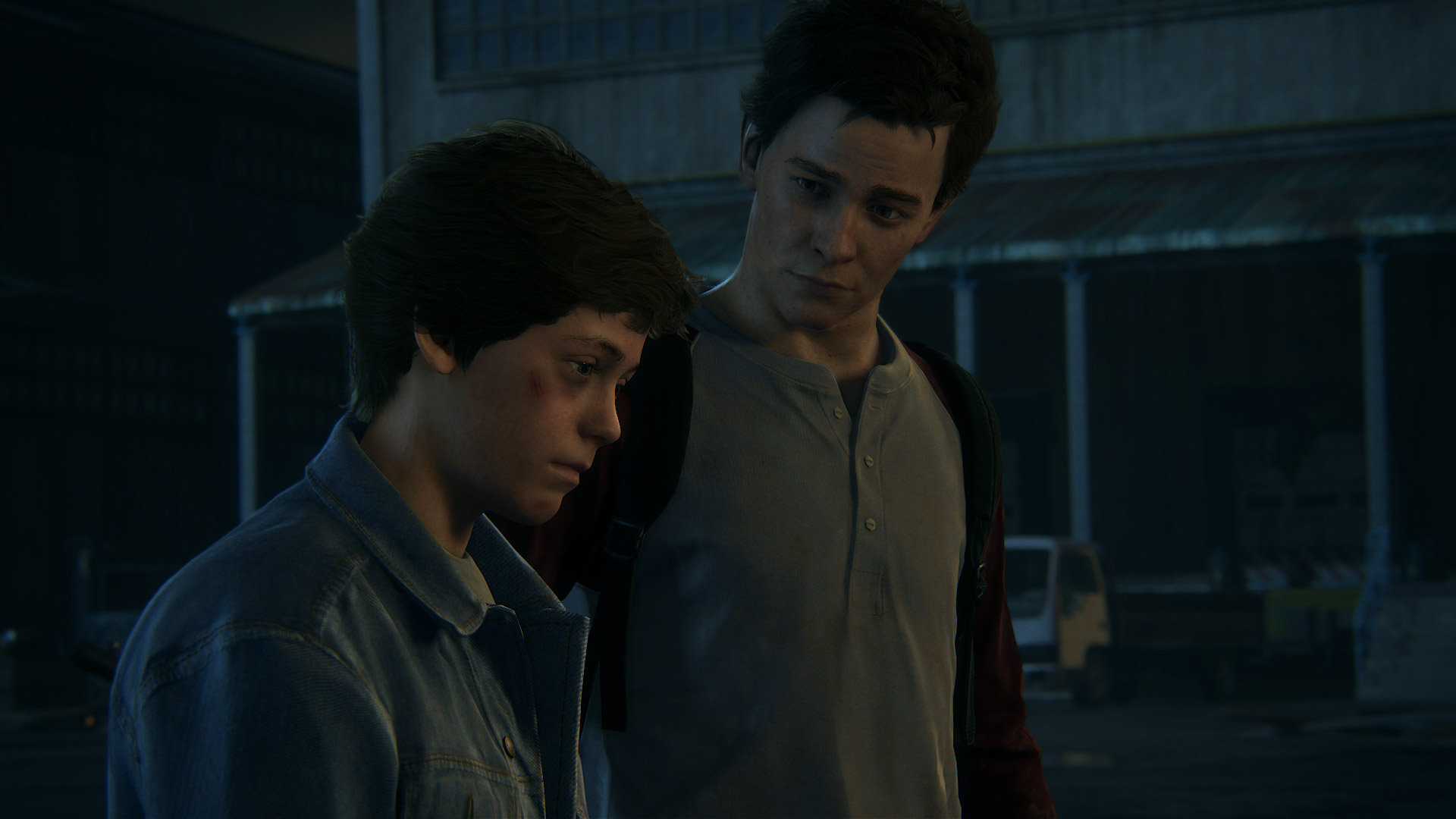
Then, in a beautiful homage to Indiana Jones and the Last Crusade, we flash forward to meet a young Nate in his late 20’s or early 30’s. He’s now an inmate in a Panamanian jail — which Nate casually joked about in the very first game — and he’s in the middle of a fistfight with another inmate.

All of this — and plenty more — happens before the opening credits even appear on screen, to the tune of the familiar Uncharted theme. Speaking of the credits, they’re filled with nods to every game in the series, and they help give the story even more of a cinematic feel. Simply put, they are gorgeous, and they set the perfect tone for the adventure to come.

From the first moment, Uncharted 4 makes it crystal clear that the scope of this game is greater than anything we’ve ever seen before.
“I am a man of fortune, and I must seek my fortune”
Every Uncharted game worth its salt needs a mythical lost treasure for our heroes to find, and A Thief’s End is no exception. In this case, we’re after the fortune of infamous English pirate Henry Avery, who escaped with nearly 400 million dollars worth of gold after committing the largest heist in pirate history back in 1695. Nate and his brother Sam have been searching for this treasure for most of their adult lives, and they’ve both paid a great price in the process. Now, it appears the finish line is finally within their grasp but, as Indy used to say, that’s usually when the ground falls off from underneath your feet.
Another recurring theme in the Uncharted series is the abundance of exotic locations, and A Thief’s End features some of the best yet. The search for Avery’s treasure takes the Drake brothers — along with a couple familiar characters and a few new faces — all around the globe, including Panama, New Orleans, Italy, the Scottish Highlands, and the African plains of Madagascar. It’s an incredible tour, and the Naughty Dog team has done a tremendous job bringing these places to life.

The scenes and backdrops in A Thief’s End are simply stunning.
However, as gorgeous as the locations are, it’s in the character department where they really knocked it out of the park.
Characters and Cast
They say a story is only as good as its characters, and the folks over at Naughty Dog definitely seem to believe that. It certainly doesn’t hurt that they always work with the best actors in the industry. Indeed, Uncharted 4 features an all-star cast led by Nolan North as usual, and featuring the immensely talented Troy Baker for the first time in the series.
But it’s not just talented voice acting that makes these characters believable. Uncharted 4’s solid writing, together with the advanced motion capture technology available today, allows these great actors to actually portray the characters themselves, and their performances shine through thanks to the hard work the graphics team put in. Simply put, this is as close to a Hollywood blockbuster movie as it gets, and I’d even go as far as to say it’s better. After all, it’s been a while since I’ve watched a movie that was this good.

Nolan North and Troy Baker portray Nathan and Sam Drake, respectively.
All throughout the Uncharted series, character development has always been the major force driving the plot forward, and here we find the most nuanced, layered and complex version of Nathan Drake to date. However, as usual, he’s not alone in his journey. Let’s take a look at some of the main characters that appear in the game.
Nathan “Nate” Drake (Played by Nolan North)
Our favorite adventurer, thief, and explorer starts the game as a changed man: he’s now married to Elena, he has a normal job, and it appears he’s left the world of adventure behind for good. In a way, he has finally allowed himself to grow up.

The problem is, growing up is boring, and old habits die hard, so when his long-lost brother Sam comes crashing back into his life, it won’t take much convincing for him to grab his trademark gun holster and get back in the game.

Domestic life may be bliss, but a little excitement every now and then never hurts.
Nolan North turns in yet another outstanding performance as Nathan Drake here. There’s a lot more subtlety to the character this time around though, and his portrayal conveys this perfectly. Nate’s age is starting to show in the way he handles certain things. He’s more measured, more controlled, but he retains nearly all of the boyish charm and quick wit that made the character so lovable in the early games. All in all, this may be North’s finest work yet.
Samuel Drake (Played by Troy Baker)
Nate’s older brother Sam, whom Nate believed to be dead, suddenly reappears after 15 years. He’s in debt with the wrong people, and he needs to locate Henry Avery’s treasure to settle the score. His life depends on it, and he’ll need his brother’s help if he’s going to make it.

Judging from the early childhood scene at the beginning, Nate’s relationship with Sam appears to be built on a solid foundation of trust: it’s the two of them versus the rest of the world as far as Nate is concerned, a dynamic that will prove decisive in the events to come. It’s no wonder then, that Nate leaves everything behind to come to his brother’s rescue. After all, that’s what brothers do.

Sam is portrayed by Troy Baker, another A-list actor who delivered what in my book is the best video game performance ever in The Last of Us. His portrayal of Joel in that game was so amazing — and spanned such a wide emotional range — that when I first learned about his involvement in Uncharted 4, I was almost afraid he’d overshadow the rest of the cast, including Nolan North. However, my fears were entirely unfounded, as Baker delivers a very contained performance here that complements North’s perfectly. The chemistry between the two lead actors is excellent, which definitely helps convey the brotherly love that exists between the characters.
Victor “Sully” Sullivan (Played by Richard McGonagle)
Sully is perhaps the character that has changed the least since we last saw him. Sure, he says he’s retired, but he still has more than a few contacts in the underground world, and he’s always ready to join the fray if it’s Nate who’s asking.
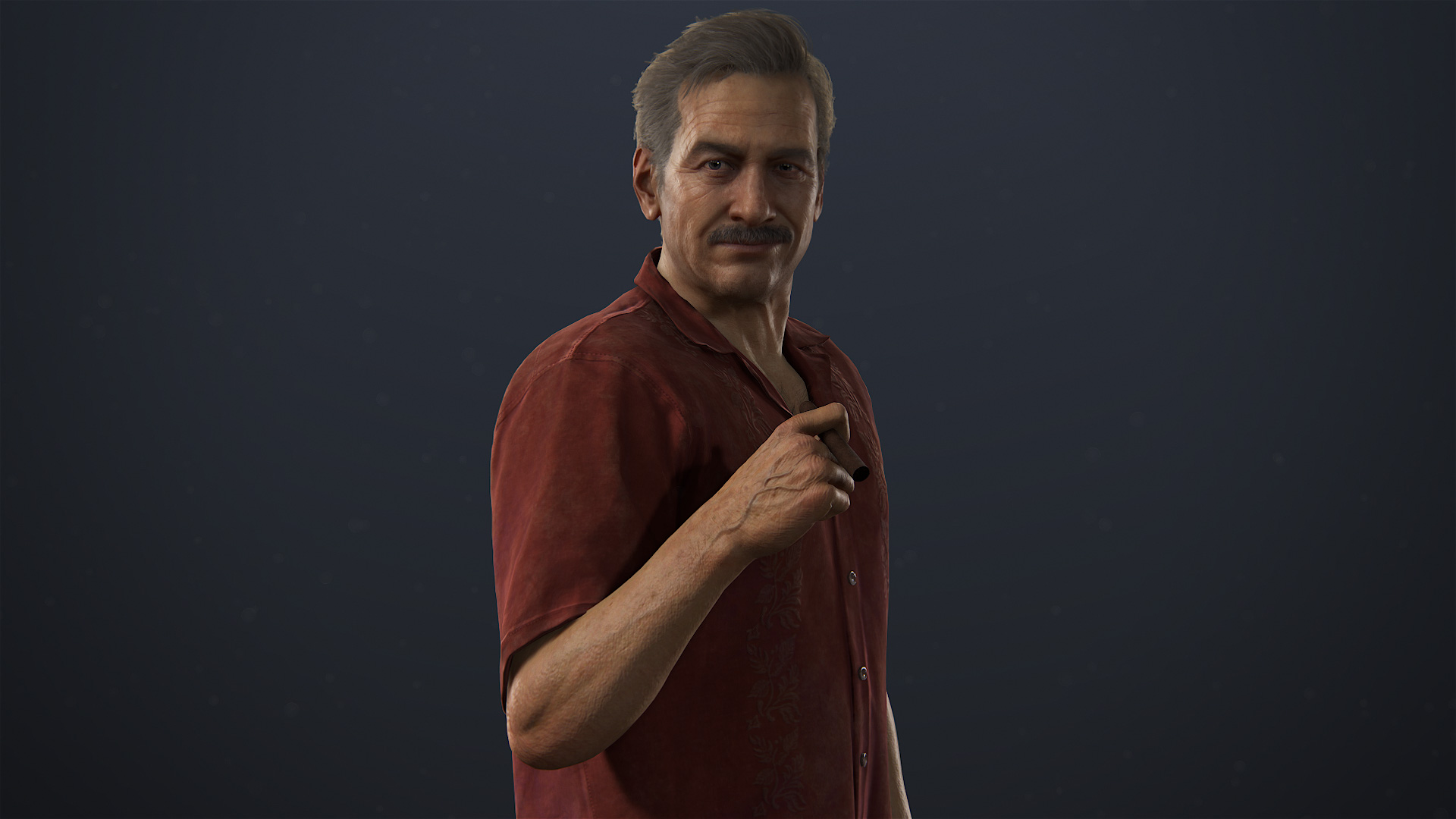
Richard McGonagle’s performance as Sully is one of those dependable things you know you can always count on. He’s so comfortable playing Sully that it seems he barely needs to act at all in order to portray the character anymore.

Sully is one of the most loved characters in the franchise, and McGonagle’s work is the reason why. Great stuff.
Elena Fisher (Played by Emily Rose)
If Sully is the least changed character, Elena is arguably the one who has changed the most. In the beginning she seems perfectly content with her ordinary life — some issues in her marriage notwithstanding — whereas in the first game she was the crazy one pushing Nate forward, and Nate was the one reluctant to keep going.

Of course, Naughty Dog knows very well what they’re doing, so fear not. As usual, there’s plenty more to Elena Fisher than meets the eye.

Emily Rose’s fourth major outing as Elena Fisher is easily her best yet, but that’s probably due to the fact that she has a lot more depth to work with here. Her character’s arc is fascinating to watch, and her relationship with Nate feels so real and well developed that you can’t help but feel a part of it.
Rafe Adler (Played by Warren Kole)
An old partner in crime of the Drake brothers, Rafe shares their obsession with Avery’s treasure, and has been looking for it on his own for over 15 years. He’s a millionaire with a bit of an inferiority complex, and the treasure is his chance to prove his worth to the criminal world once and for all.

Nate and Sam’s search for Avery’s treasure means they’re now Rafe’s competitors, and as the brothers soon learn, he’s not someone to turn the other cheek when crossed.
Other than his appearance in a couple episodes of USA Network’s White Collar, I wasn’t very familiar with Warren Kole’s previous work, but his portrayal of Rafe is definitely one of the highlights of the game. Despite his psychopathic tendencies, Rafe is a complex character with a rich background story and a clear motivation behind his actions. It’s rare in the video game world to see an antagonist so well developed, and Kole definitely seized the opportunity to deliver an impressive performance here.
Nadine Ross (Played by Laura Bailey)
Nadine is the only main character who doesn’t get a proper arc in the game, and that’s too bad. She’s a tough-as-nails mercenary working with Rafe to locate Avery’s treasure, but her background is never really explained, and we never get any character exploration to help us understand the reasons behind her actions.

Laura Bailey does the best she can with the material she’s given, but unfortunately there isn’t much to work with here. It really is a shame, because the character has a lot of potential, and the game could have used another strong female character to help balance out the excess of testosterone emanating from the main cast.
As it is, Nadine is definitely strong, but the lack of character development means she always comes across as too one-dimensional, and more of a glorified henchwoman than Rafe’s partner and equal.
A rare missed opportunity for Naughty Dog here, but I guess you can’t win them all.
Writing and Direction
The development of Uncharted 4 was somewhat rocky, as long-time series writer and creative director Amy Hennig and game director Justin Richmond both left the studio in March 2014, with the project still in the early stages.
Luckily for everyone, Neil Druckmann and Bruce Straley, the creative team behind The Last of Us, assumed control of the project and continued developing it until its eventual release. To make a basketball analogy, that’s like losing Kobe Bryant for the next few games and having to make do with Michael Jordan instead.

Uncharted 4 is a masterfully executed installment in the series and Druckmann and Straley are where the genius lies.
Indeed, Druckmann and Straley have once again managed to create something special with Uncharted 4. While the story never quite reaches the dramatic heights of The Last of Us, it is still one of the best video game plots ever, and a fitting conclusion to the Uncharted series.


The themes that are explored over the course of the story — family, trust, friendship, love, partnership — are all familiar.
The themes that are explored over the course of the story — family, trust, friendship, love, partnership — are all familiar, but there’s also an added hint of nostalgia that makes them hit a lot closer to home than any other game in the series.
The previous Uncharted games all tipped the scales — if only slightly — in favor of the action, but Uncharted 4 manages to balance both sides of the equation perfectly: there’s certainly enough action to keep things fun and dynamic, but there’s also enough character development to make this clearly a story about people, not treasure. That’s an important distinction, and one this game makes brilliantly.
Clearly, Druckmann and Straley are two of the most talented video game developers ever, and I for one can’t wait to see what they’re going to do next.

Music
I’m admittedly not an expert when it comes to soundtracks, but I think Uncharted 4’s score, composed by Henry Jackman, plays a rather understated role in the game. Other than the fast-paced action scenes, I don’t really remember noticing the music all that much during my first playthrough, but this isn’t necessarily a bad thing.
Since finishing the game, I’ve played the soundtrack a few times on Spotify and it feels like a solid score overall, with more than a few tracks worth listening to. The most notable among them, of course, is the title track — A Thief’s End — which plays during the game’s opening credits and features a very interesting interpretation of the classic Uncharted theme.
In general, I’d say the score is more dramatic this time than in previous games, and there’s more of a sense of danger, tension, and urgency. The stakes are definitely higher in the game, and the score seems to reflect that nicely.

Graphics
What’s more important for a game to be successful, the graphics or the story? Instinctively, I’m inclined to answer both, but the truth is, we’ve been playing games for a lot longer than we’ve had excellent graphics, and it’s always the stories we keep coming back to. That’s partly why this review admittedly focuses more heavily on the story aspects than the technical ones.

With such a great story and characters, I have no doubts Uncharted 4 would have been a successful game even if its graphics had been average. Luckily, Naughty Dog just doesn’t seem to know how to make an average-looking game.

The level of detail throughout the game is simply unmatched. Every character, landscape, and environment can take your breath away.
Simply put, Uncharted 4 is the best looking console game ever made. Seriously, it’s that good. If I had to come up with something to complain about in the graphics department, it would be that the single player campaign runs at only 30 fps. This may seem poor at a time when 60 fps is quickly becoming the norm, but in practice it’s never a problem during gameplay, and I never noticed any significant drops in framerate.

Aside from that, everything about Uncharted 4 is gorgeous, including the character models, the landscapes, and the way the environment reacts to the action. Things like the grass flowing with the wind created by an explosion, mud leaving stains on vehicles, and the characters gaining scratches and wounds over time are all great examples of this. My personal favorite is the way Nate’s hair and skin get wet whenever he comes in contact with water. It’s little details like those that help bridge the gap from “pretty good” to “absolutely stunning”.

Nate’s hair and skin get visibly wet when he comes in contact with water.
However, perhaps the most impressive aspect when it comes to Uncharted 4’s technical chops is one that’s not readily apparent at first. Everything in the world now seems to have a proper weight that influences how objects, characters and the environment interact with each other. If, for example, Nate falls from a balcony, he’ll trip to his hands and take a couple of stumbles until he regains his balance. This new physics engine governs every single object and character in the game, and helps give the game world a sense of realism that surpasses anything ever achieved in the medium before.

The new physics engine gives weight to Nate’s movements, which greatly improves realism.
Such painstaking attention to detail is of course one of Naughty Dog’s classic trademarks, and Uncharted 4 is easily their best work yet. If you were looking for a reason to buy a PS4, I can’t think of a better one than this.
Gameplay: a winning formula, perfected
Everyone knows not to mess with something that works, which is why many people were understandably worried when the news about Amy Hennig’s departure broke. The concern was that Druckmann and Straley, who were coming over to the franchise fresh off completing The Last of Us, would turn the series in a darker direction, losing its essence in the process.

To make matters worse, the first teaser for the game released under Druckmann and Straley’s direction featured a wounded Nathan Drake regaining consciousness in a creepy tropical setting, complete with a dead-serious conversation between Nate and Sully, and the ominous title of A Thief’s End, all of which certainly aggravated some of those fears. Luckily, the final game proved those concerns to be completely unfounded.

At its core, Uncharted 4 is still very much an Uncharted game. All of the familiar elements are still there, including the long traversal sections, the combat, the puzzles, the humor, and the spectacular locations. Also present is the trademark light-hearted tone that’s become synonymous with the series. It’s the closest you can get to being in an Indiana Jones movie, and it is a ridiculously fun gaming experience.

Replace the lemur with a monkey and it’s Raiders of the Lost Ark all over again.
However, that’s not to say there aren’t any important changes here. Let’s take a closer look at some of the most innovative gameplay elements introduced in Uncharted 4.
Traversal
The traversal sections of the game, one of the most recognizable aspects in the Uncharted games, retains most of its classic elements, including the lush environments, the climbing, the jumping, and the occasional vehicle driving. However, Uncharted 4 builds upon those elements by adding a few new ones, like the grappling hook that allows Nate to swing from a rope to gain access to previously unreachable places.

Speaking of climbing, it has also been vastly improved in this game, with Nate’s movements looking much more realistic. The new physics engine is definitely put to good use here, and you now have the opportunity to slowly transition from hold to hold just by moving the left analog stick, which will cause Nate to accurately use real climbing techniques to move on the wall.


However, the biggest change Uncharted 4 brings to traversal is probably the inclusion of multiple paths. A frequently cited shortcoming of the Uncharted games is that they are too linear, and players often feel like they have little say in the way the story progresses. Now, Uncharted 4 is still very much a linear game, but there are often multiple routes to the next point of interest, creating an illusion of non-linearity that greatly improves the experience. It’s not real choice, but it’s certainly better than no choice at all.
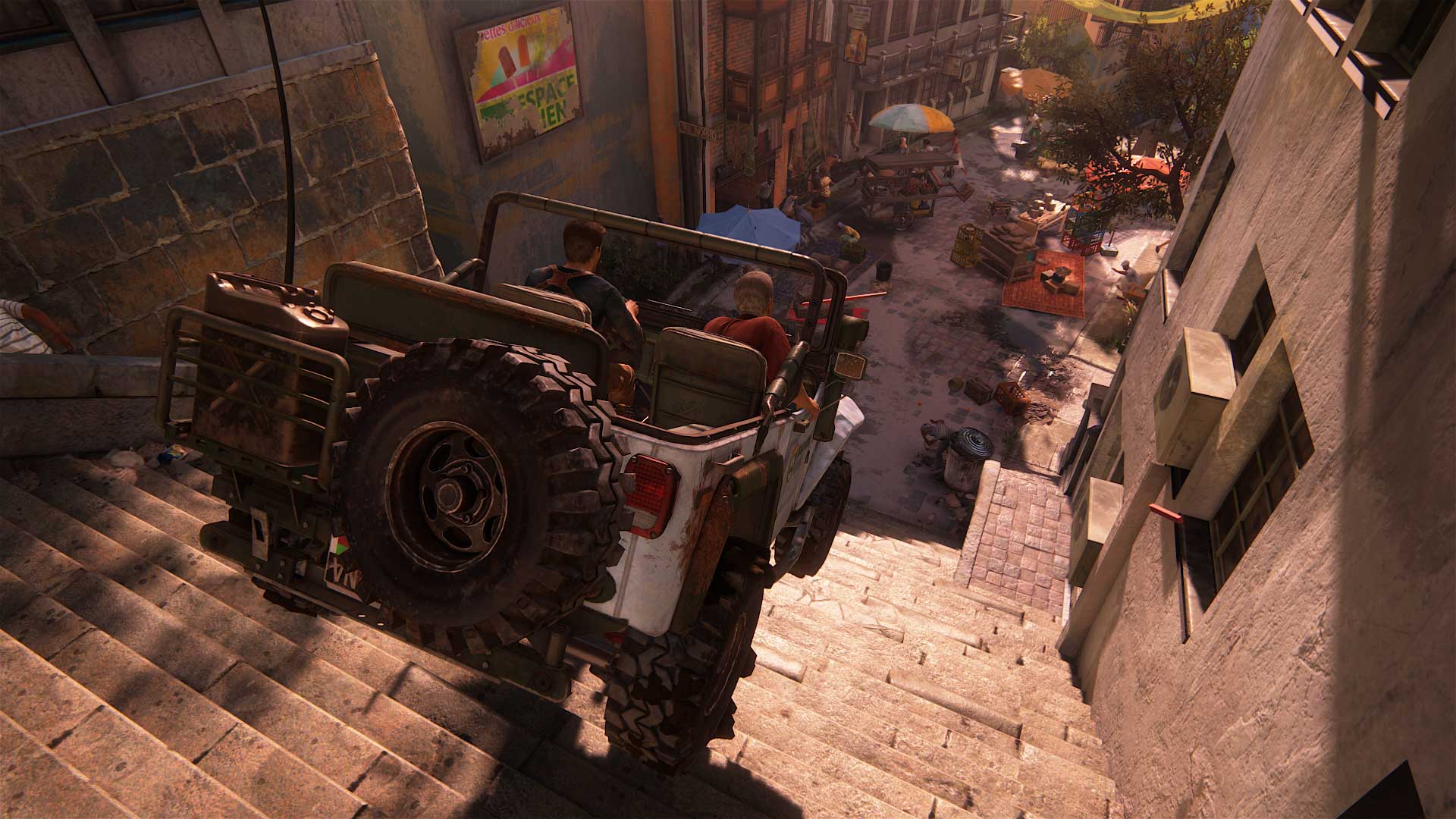
The jeep chase that was demoed at the 2015 E3 conference features multiple paths that help create an illusion of non-linearity.
Combat
Combat sequences in the Uncharted series have progressively gained in complexity and dynamism with each game, and that trend continues with Uncharted 4. Among other things, players can now jump on enemies to take them out with a single blow, pick up their weapons on the fly and keep shooting, all without ever stopping down. It’s an exhilarating, adrenaline-fueled process, and it’s super fun.
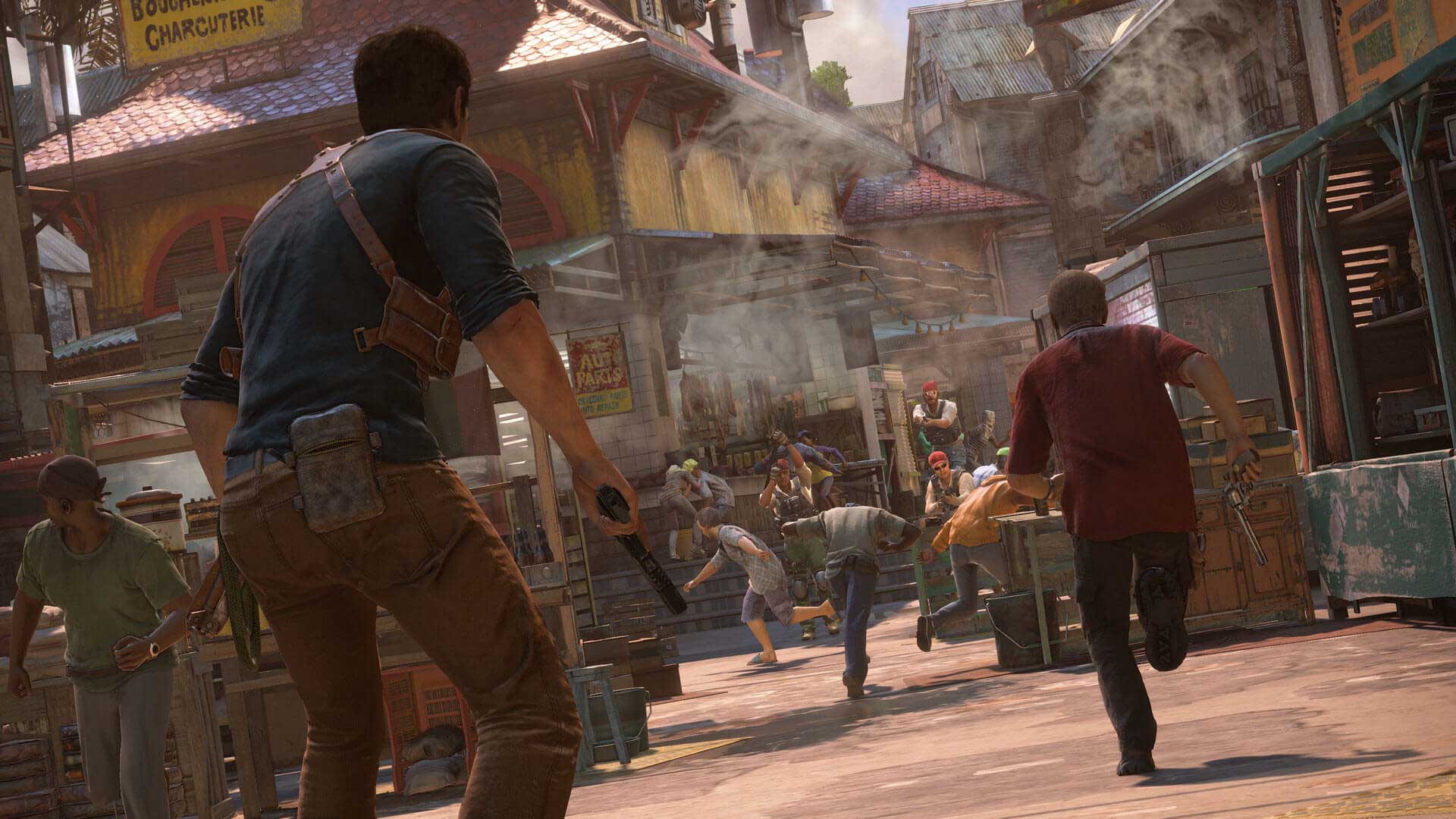
The most meaningful addition to combat in the game is probably the possibility to use tall grass and other forms of vegetation as cover, which allows Nate to remain hidden from view and use stealth techniques to take his enemies down without alerting them to his presence. This opens up a whole new dimension in the game, and I greatly enjoyed using stealth as often as I could during my first playthrough.

Enemy behavior has also been improved, thanks to a more sophisticated AI engine that allows them to coordinate in order to flank you and work as a group. Furthermore, they now have finite attention spans, which players can use to their advantage when overwhelmed in battle. If you manage to stay out of sight long enough, enemies will lose track of you and lower their alert level, allowing you to continue using stealth to gain the upper hand.

Other features that improve the combat experience include a couple aids to improve the player’s control in tricky situations. Lock-on aim is a super handy feature that automatically places the player’s aim on an enemy, vastly improving shooting accuracy. If you enjoy the challenge of the combat scenes you may want to turn this off, but if you’re in this for the story, I personally recommend leaving it on. Yes, combat sequences sometimes feel a little too easy this way, but the rest of the game more than makes up for it.

Another similar feature is camera assist, which automatically keeps the camera behind the player’s character at all times. Managing the camera while you’re driving or shooting your way out of a tight spot can be maddeningly difficult, and this feature definitely makes it more manageable. Unlike lock-on aim, though, I only turn camera assist on when I need it — often after dying a couple times in the same spot.
Puzzles
If there’s one thing in Uncharted 4 that feels inferior when compared to the previous games, it’s gotta be the puzzles. Not only are there way too few of them, but they’re also ridiculously easy to solve, and if by some miracle you don’t immediately come up with the right solution, one of your accompanying characters will gladly give it to you in a matter of minutes. Sam in particular is extremely annoying here, as he tends to spoil every single puzzle you encounter if you don’t solve it fast enough.

One of the few major step backs of A Thief’s End is in the number of puzzles. The latest game has the fewest of the series.
I understand that getting stuck in a game because of a puzzle is frustrating, but including puzzles that are too easy just for the sake of having them is not exactly a good solution to that problem either.
Trophies and Journal Entries
Beyond the main story goal, every Uncharted game features lots of hidden trophies that are often hidden in non-essential parts of the game for the player to find and collect. Think of them as a way for developers to reward players for exploring the game world beyond the obvious path, and while it’s not an aspect I particularly enjoy, I do know of a few people that are dead-set on collecting every last one of them.
Given the slightly less linear nature of Uncharted 4, there’s ample opportunity for non-essential exploring throughout the game, so finding all of the hidden trophies can help tenacious players get quite a few more hours out of the game, which is always welcome.
Beyond trophies, players can now also collect optional journal entries by examining certain areas in detail. These can then be viewed at any point by inspecting Nate’s journal, and some of them are pretty cool indeed.


Photo Mode
One of the most exciting additions in Uncharted 4 is the new Photo Mode. It’s essentially a built-in tool that allows players to freeze the action at any point and take complete control of the camera. Players can then play with it as they please, by moving the camera around, for example, or playing with lens and camera-specific elements like depth of field, zoom, angle of view, etc. They can also capture pictures and apply a wide selection of filters to them, and then share those images directly on Twitter and other supported social networks.

One of the most exciting additions in Uncharted 4 is the new Photo Mode.

This may sound like a silly addition, but it’s hands down one of my favorite things about the game. In fact, it’s so much fun that about halfway through I had to constantly refrain from launching the Photo Mode in order to avoid getting distracted from the action every two minutes, and even then I still managed to take well over a hundred pictures during my first playthrough. In fact, most images in this review were captured in Photo Mode, and there are lots more I had to leave out.

I don’t know why it’s taken so long for Photo Mode to be a thing, but I for one hope it’s here to stay.
Multiplayer
I must confess to not being at all interested in the multiplayer mode of any of the Uncharted games, and this one is no exception. It just seems counterintuitive to mix that aspect with this type of game, but to each their own.
The multiplayer mode in Uncharted 4 runs at 60 fps — compared to 30 fps for the single player campaign — and features lots of different elements that are not present in the main game. The most notable of those is probably the existence of “Mysticals”, which are supernatural elements that can temporarily boost a player’s abilities. Players can also invoke sidekicks for assistance, including the Hunter, the Savior, the Sniper, and the Brute, each of whom possesses different skills.

The game features several competitive multiplayer modes, and Naughty Dog has hinted at a possible cooperative multiplayer mode in the future. All in all, this should allow interested players to get quite a bit more life out of the game.
Ludonarrative Dissonance
If there’s one criticism that’s leveled at the Uncharted games more often than any other it has to be the fact that they’re the poster child for ludonarrative dissonance.
This term refers to the difference that sometimes exists between a video game’s narrative and its gameplay, and is exemplified by Nathan Drake more than any other character. During the cutscenes, Nate is a lovable character with a strong moral compass, who will often avoid violence and refuse to kill enemies whenever possible. However, during gameplay Nate carelessly murders hundreds of not-so-innocent people — but people nonetheless — in every game without so much as batting an eye.

An example of ludonarrative dissonance: During the cutscenes, Nate is a lovable character with a strong moral compass, who will often avoid violence. However, during gameplay, Nate carelessly murders hundreds of not-so-innocent people.
This dissonance is unfortunately a necessary evil, as it’s the only thing that allows combat to exist in the games in any way, without turning Nate into a murderous psychopath nobody would ever root for. If you have a problem with this, my advice is that you simply try let it go or, failing that, ignore it, because there’s just no way around it.
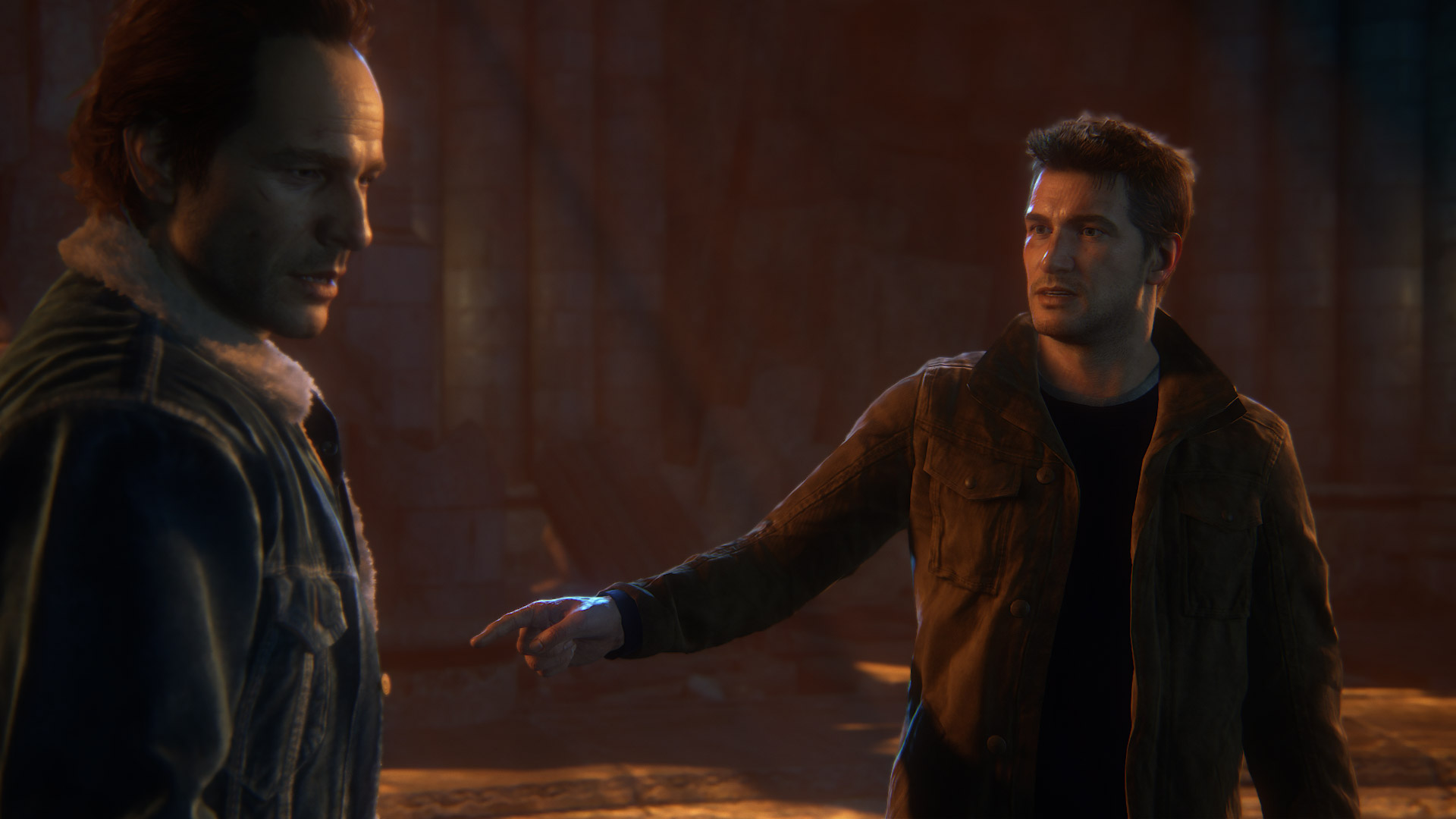
To be fair, ludonarrative dissonance not only affects video games. The universally loved Indiana Jones films also suffer a fair bit from it, since Indy has a nasty habit of killing a few too many people on every adventure, and he too doesn’t seem to lose any sleep over it — literally. If it’s OK for Indy, in my book it’s certainly OK for Nate, too.

Much to their credit, the Naughty Dog folks are well aware of the issue, and they’ve even created a special trophy in the game called — you guessed it — ludonarrative dissonance. It unlocks when you kill 1,000 enemies across all forms of gameplay, and it’s perhaps one of the most clever nods to the audience I’ve ever seen in a video game.
Well played, Naughty Dog. Well played.

Sic Parvis Magna
Sir Francis Drake’s motto — greatness from small beginnings — is often repeated throughout the Uncharted games, and it perfectly describes the story and evolution of the franchise as a whole.

The Uncharted story began almost a decade ago with an ambitious but less than perfect game that somehow managed to capture the imagination and hearts of an entire generation of gamers. Today, that same spirit is still alive and well, but the series has undeniably reached maturity, and with it, a level of technical and creative excellence that has significantly raised the bar for the entire video game industry.

Naughty Dog has done it again. Uncharted 4 is a breathtakingly beautiful game that brings a deeply satisfying conclusion to one of the most popular video game sagas ever. It is ambitious, emotional, fun and exciting in equal measures, and it’s one of the most rewarding gaming experiences of all time. I can wholeheartedly recommend it.